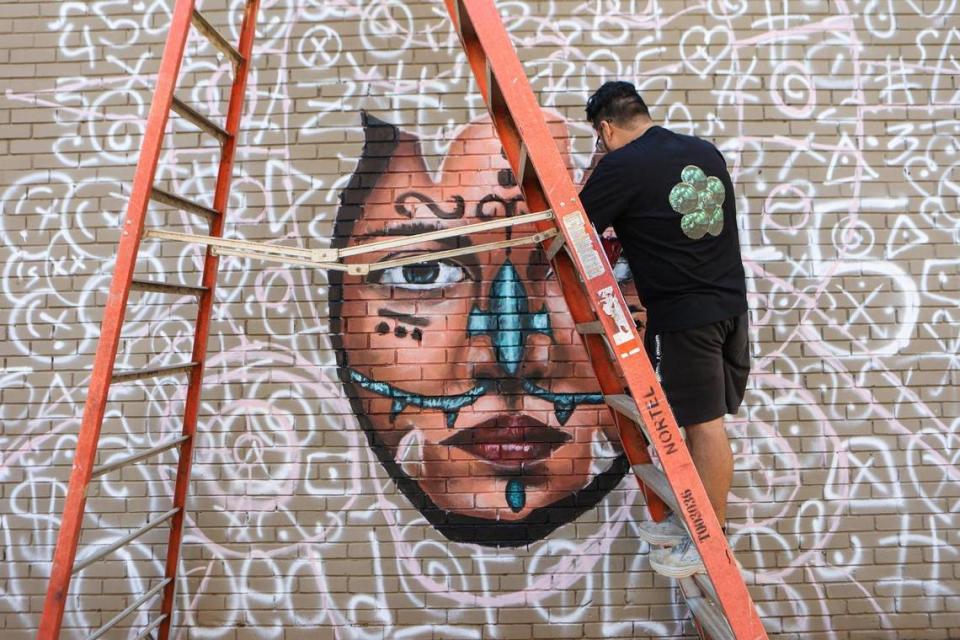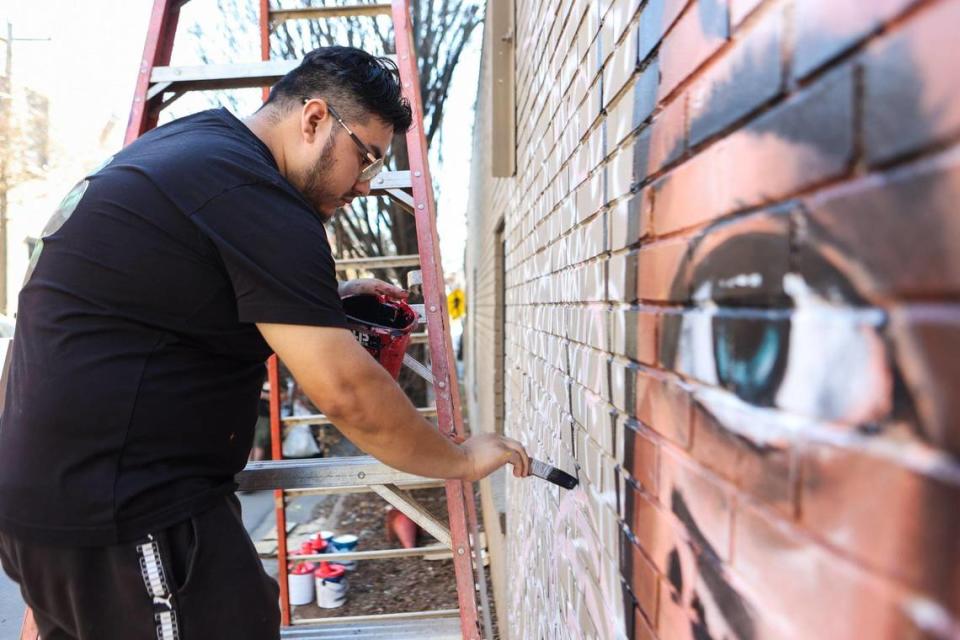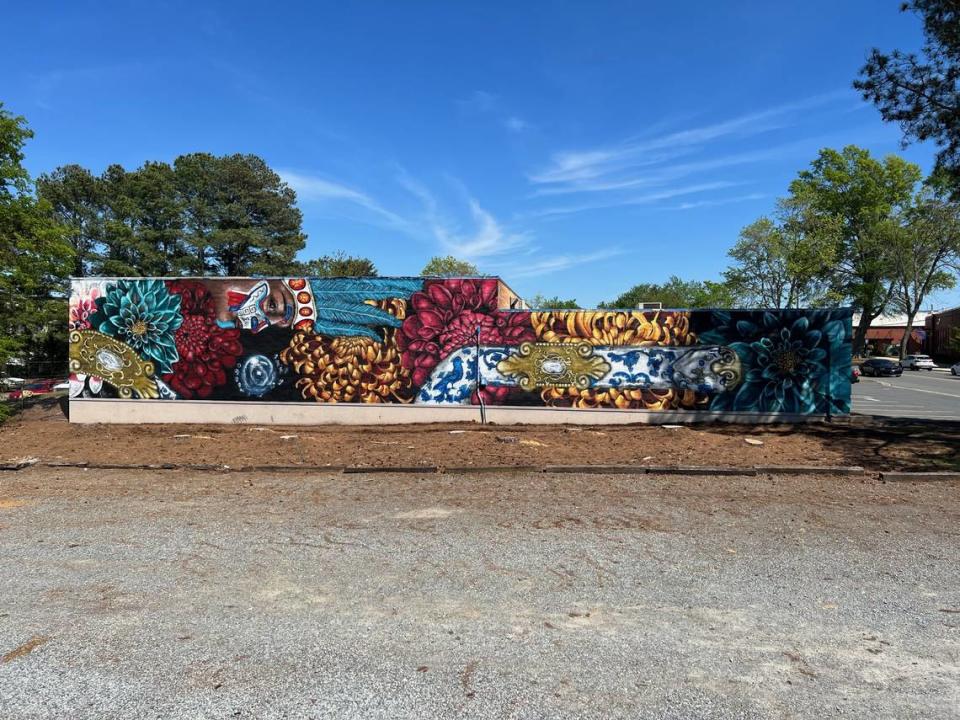A new Charlotte mural project celebrates Latin American artists and community
A few months ago, Jose Valentin Ramirez Cardiel had never painted a mural. Now, the 24-year old visual artist just wrapped up working on his third large-scale outdoor work.
As he adds color to walls across the city, he’s hoping his paintings will inspire other Latin American artists to dream big and see themselves as vital contributors to Charlotte’s arts community.
The murals are part of an initiative Ramirez recently launched called Street Culture Arte. His goal: celebrate Charlotte’s diversity by increasing the visibility of Latin American artists. The project will include at least eight murals across the city to be completed by June 2024.
Ramirez already has enlisted two other local artists for Street Culture Arte — Giselle Hernandez and Damalis — and he’s hoping to connect with others, too.
“I’m looking forward to (getting) more artists to be able to put their footprint out here,” he said, “and showcase their artwork as well.”
Street Culture Arte received funding through a $3,000 Arts & Science Council Artist Support Grant and a $20,000 Opportunity Fund Grant, part of the city of Charlotte’s temporary public-private initiative known as the Infusion Fund.
Ramirez’s vision for the project is that there will be enough murals around town where people “actually feel this connection, and see that Charlotte has a diversity of murals and artists.”

Importance of ‘The Day of the Dead’
Ramirez grew up in Charlotte with his three siblings in an apartment near South Boulevard. His parents are both immigrants from Guanajuato, Mexico, and those roots now take on a prominent role in his artwork.
Ramirez’s family spoke Spanish at home and he grew up immersed in certain popular Mexican customs, like the sweet 15 parties known as quinceañeras, traditional dances and piñatas. His mother also would share stories about the posadas of her youth, when families would walk around the town for nine nights and each home would host small parties for the children in the days leading up to Christmas.
But it was only about two years ago that he started learning about el Día de los Muertos (“The Day of the Dead”).
His family never observed this occasion but its cultural aspects intrigued him.
El Día de los Muertos takes place Nov. 1 and 2 with festivities often starting several days before. Its origins can be traced back thousands of years in Mexico to traditions observed by the Aztec, Toltec, and other Nahua people.
In its contemporary form, families mark the occasion by creating ofrendas (“altars”) at their homes or at cemeteries for their loved ones who have died. They are decorated with items like photos, flowers, candles, traditional foods and water for spirits believed to be making the long journey back to the living world.
“I loved everything about it,” Ramirez said, “from the flowers, offerings, celebrations and artwork.”
It’s a celebration, rather than a time of mourning, when ancestors are remembered and welcomed back.
There are parades, costumes and candies evoking the image of la calavera Catrina (“the elegant skull”), originally a satirical symbol that has become the most widely recognized icon of the holiday. It’s based on a painting by muralist Diego Rivera — who drew inspiration from an early 20th century engraving by Mexican political cartoonist José Guadalupe Posada.

As Ramirez learned more about its traditions, the iconography and colors of Día de los Muertos have taken a central role in his artwork.
Not only did they inspire the oil paintings he created last fall for Day of the Dead celebrations at Camp North End, but also a picnic table he painted for the inaugural Charlotte International Arts Festival, and a custom jersey he designed for February’s 704 Night at Spectrum Center.
It also inspired his first mural for the Street Culture Arte project on a wall outside of Maria’s Mexican Restaurant (5234 South Blvd.) in Charlotte.
In this and other works, Ramirez incorporates his own twist by including what he calls “Chrome Flowers” into his designs. Based on decorative balloons, they represent self-reflection and growth. We’re each unique, Ramirez said, like flowers with different colors, shapes and petals.
“You’re here to bloom and enjoy life as much as (you) can,” he said. “And then you’re gone but… you have left a legacy behind.”
Encouraging Latino artists
That legacy is something he’d like to see more of from other Latin American artists who are not as visible as they should be in the city, he said. He wants more people to see Charlotte’s diversity and connect with the beauty of Latin American cultural traditions.
“They’re not really getting out there and interacting with other artists, communicating, and… not putting their footprint out into the city,” he said.
“A thing that is definitely holding a lot of Latin community artists back is that most of us grew up in labor” jobs, Ramirez added.
In his youth, Ramirez worked alongside his father in the family’s landscaping business. It’s common for Latino families to work hard to support their families, he said, but it can also steer people away from creative ambitions.
“So when you tend to say, you know ‘I want to be an artist,’ it’s not something they’re looking forward (for) you to be,” he said. “More like a lawyer or a doctor.”

How Ramirez got his start
As a high school student at Hawthorne Academy of Health Sciences, Ramirez planned to pursue a medical career working for the Centers for Disease Control and Prevention. But he always had a passion for art. He participated in juried high school competitions and frequently won first place.
“I knew I had something in me that I could become more,” Ramirez said.
His senior year, he also had the opportunity to take an introductory oil painting class at Central Piedmont Community College, with all course fees covered by his high school. After high school graduation, however, Ramirez lacked the funds to continue to college, so he kept practicing what he had learned and started pursuing art in the real world.
At first, his family didn’t like his decision to pursue art. But that has changed. They are supportive now, he said, seeing the changes he is trying to bring to Charlotte and his work to elevate the visibility of the Latin community.
Connecting with other Charlotte artists has been a key element of finding new opportunities to showcase his artwork. And funding has been essential.
Knowing he had grant money for the first mural at Maria’s from the ASC gave the project a boost. “That was a lot of help for me,” he said. “It started out my career in being able to make this all happen, because of them.”
Historically, funding in Charlotte for Hispanic artists has lagged behind other racial and ethnic groups. In 2020, according to the ASC Equity Report, only 6% of the recipients of ASC Grants to Creative Individuals identified as Hispanic/Latinx, compared to 9% who identified as Asian, 36% as Black, and 43% as white. (Another 6% were listed as “self-identified.”)
Meanwhile, Charlotte’s Hispanic population has been rapidly expanding. According to Carolina Demography, Hispanics currently represent 15.2% of Mecklenburg County’s residents.
Both the ASC and the city of Charlotte describe equity and inclusion as key considerations in their grant-giving work.
For Ramirez, inclusivity and connection is key to motivating other Latin artists so “they can come out here and showcase their artwork on a larger scale and not be scared to be able to do something like this.”
The 311 on Jose Valentin Ramirez Cardiel
Follow Jose Valentin Ramirez Cardiel on Instagram: @dead_folks
Current mural locations for Street Culture Arte in Charlotte: Maria’s Mexican Restaurant, 5234 South Blvd., Anodernary Furniture Designs, 201 W Worthington Ave., CITI, INC., 4030 Yancey Road.
More arts coverage
Want to see more stories like this? Sign up here for our free “Inside Charlotte Arts” newsletter: charlotteobserver.com/newsletters. And you can join our Facebook group, “Inside Charlotte Arts,” by going here: facebook.com/groups/insidecharlottearts.

